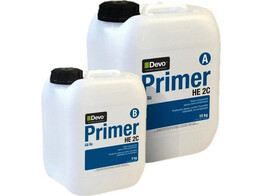01 June 2023
Guidelines for installing parquet on cement screeds
Discover essential guidelines for installing parquet on cement screeds. Follow these tips for a successful installation.
- Before installing parquet, check the screed floor for the following factors:
- Flatness;
- Structure;
- Solidity;
- Moisture content.
- Flatness:check the screed floor with a ruler of at least 2m. The tolerance is 2 to 4mm over 2m, depending on the type of parquet to be installed.
- Structure:check for cracks, fissures and loose parts. Depending on the cause, cracks and fissures can be repaired or filled with suitable products. Loose parts are best removed and filled. For example, use a mixture of Devo Primer Express PU or Devo Primer HE with fine, dry sand.
- Solidity (surface cohesion): minimum 0.5 N/mm². There are complicated tests and methods of measurement to determine whether the screed floor meets the surface cohesion requirements. A simple test can be done as follows: Check the firmness of the screed floor by scratching the surface with a scratch pen. If the screed is not sufficiently compact or there is "silting", carry out a pretreatment with Devo Primer PA400 ½ to ¼ diluted with Devo Diluente D40. This treatment will make the top layer of the screed very firm and solid and will significantly increase the tensile strength and adhesion capacity of the adhesive. Caution!!! This type of treatment is only effective in the upper centimeters. If the depth of the screed is also questionable, it is best to break it up and install a new one or to lay the parquet floating. For a very superficially silty or dusty screed, use Devo Primer Express PU. This has the big advantage that you can start gluing after 40 minutes (in optimal conditions).
- Moisture content: The maximum moisture content in a screed floor is in principle 2%. The exact determination of the moisture content should be done with the CCM Carbuurmeter. Evaluation measurements or global measurements can be done for time-saving reasons with an electronic moisture meter (e.g.: Protimeter Aquant). The final determination is always done in at least 2 to 3 measurements with the CCM Carburemeter. Indicatively one should take into account 1 week of drying per 1cm of screed thickness. The drying can be influenced by heating the room and installing a construction dryer. It is important to always take the "overall picture" into consideration; building moisture in the masonry and in the wall occupation as well as the relative humidity of the air have an influence on the overall situation and the drying process of the screed floor.
- In case of an existing screed floor, any glue residues or other surface layers must first be removed. The Devo Diamond and PCD disk are best suited for this purpose. Obviously the screed floor must also meet the previous requirements.
- Always use the appropriate type of glue and glue comb, depending on the state of the substrate and the type of parquet to be installed. For most gluing applications directly on screed we recommend our glue comb n°1, with a tooth width of 5mm, height of 10mm and tooth spacing of 10mm.
- Always keep the glue comb straight during gluing. In this way you will transfer the profile of the glue teeth to the floor in an even glue bed. The glue comb should also always "scrape" well, between the glue beads there must be no glue on the substrate. Glue combs will wear out from this. Regularly check the profile
of your comb with a new one. If your glue comb is too worn you better take a new one, so that always an optimal glue bed is placed. - Never apply more glue on the floor, than you can place parquet within the open time of the respective glue.
Note
- As in any home where there is a parquet floor, keeping the relative humidity (RLV) stable between 40 and 70% is very important to prevent damage.
- For the proper use of specific products described here, please refer to the corresponding technical sheet.
- The information described here is based on our years of experience and research, and intended to provide technical support to our esteemed customers. Since the method of application cannot be controlled or influenced by us, no liability can be accepted on the basis of this data.
- Our product warranty covers only the quality of our products, their correct application belongs to the responsibility of the user. For specific applications, please always seek advice from our technical advisors.




